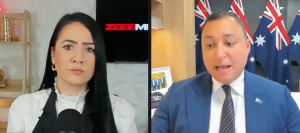Questions arise as South Australia appoints a ‘Minister for Autism’


Photo: TAN
Why the need for such a position?
MINISTER FOR AUTISM
The South Australian government recently announced the appointment of Emily Bourke to the role of Assistant Minister for Autism. It’s the first portfolio of its kind in Australia.
Bourke, who is already Assistant Minister to the Premier, will now be responsible for delivering Labor’s ‘autism election commitments’, in conjunction with the ministers for education and human services.
 Her appointment will help get rolling a number of new initiatives to support the increasing numbers of autistic children, including an investment for an autism “lead teacher” within public primary schools.
Her appointment will help get rolling a number of new initiatives to support the increasing numbers of autistic children, including an investment for an autism “lead teacher” within public primary schools.
The minister will provide coordination of matters relating to autism across government systems.
Additional investment includes for areas such as clinical health services, occupational therapists, psychologists and counsellors will bolster support for autistic children in the community.
The appointment of a minister specifically responsible for autism has been described as a “landmark moment”, but it also raises questions about why a specific focus on autism has been chosen.
Have things gotten so bad, or are predicted to get so bad, to the point that this is now needed?
Why does one particular disability group all of a sudden need a dedicated ministry?
Do they know something that we do not know?
I often wonder about the celebration of new drugs or systems to aid the sick and ill.
We see it on the news often: A new ‘miracle breakthrough’ to help patients with chronic diseases.
There is often a positive tone associated with a new cure or system of assistance, but no concern is given as to why the disease or ailment in question has become so prevalent in the first place.
A new pill to help solve cancer is great, sure. But why was cancer allowed to get this bad over decades?
Likewise, why are we celebrating the appointment of a Minister for Autism, but are not crying out in concern about the need for one in the first place?
You see what I’m saying here?
Coming in to ‘help manage’ a disease once it has become widespread is not the same as actively participating to solve the issue early. Instead, it begins to do the opposite. It begins to normalise it.
Normalising a neurological condition that has increased dramatically in recent decades.
WHY THE INCREASE?
Twenty years ago, autism was a relatively rare diagnosis, identified in around one in every 2,000 people.
The turn of the 21st century saw a steep increase in the numbers of people being diagnosed with autism.
 An increase in the incidence of autism was observed, and some estimates now put the prevalence of autism in Australia at one in every 50 people – a 40-fold increase in 20 years.Today, approximately 34% of all participants within the National Disability Insurance Scheme (NDIS) have a primary diagnosis of autism. This figure increases to 55% of NDIS participants under 18 years of age.
An increase in the incidence of autism was observed, and some estimates now put the prevalence of autism in Australia at one in every 50 people – a 40-fold increase in 20 years.Today, approximately 34% of all participants within the National Disability Insurance Scheme (NDIS) have a primary diagnosis of autism. This figure increases to 55% of NDIS participants under 18 years of age.
SA sits above the national average with 39% of South Australian NDIS participants having autism.
Over 200,000 Australians are autistic. 1 in 4 Australians has an autistic family member.
The ‘experts’ will tell you that this increase is associated with ‘broader diagnostic criteria’, ‘greater awareness of autism among parents and clinicians’, and a ‘reduction in stigma’ with the diagnosis.
But perhaps there are a few ‘elephants in the room’ that are being overlooked.
This discussion becomes interesting when you compare the ‘disorder’ to mercury poisoning symptoms, which can cause very similar immune, sensory, neurological, motor and behavioural dysfunctions.
Mercury poisoning has similar traits to those defining or associated with autism, and researchers suggest the similarities extend to neuroanatomy, neurotransmitters and biochemistry.
 According to another report, environmental contribution to autism is due in large part to the sensitivity of the developing brain to external exposures such as lead (Pb), and mercury (Hg) as toxic heavy metals.If we go a little deeper down the rabbit hole, we begin to discover vaccines, with researchers finding that mercury still remains in the Infanrix Hexa vaccine given to Australian children.
According to another report, environmental contribution to autism is due in large part to the sensitivity of the developing brain to external exposures such as lead (Pb), and mercury (Hg) as toxic heavy metals.If we go a little deeper down the rabbit hole, we begin to discover vaccines, with researchers finding that mercury still remains in the Infanrix Hexa vaccine given to Australian children.
 Let’s also not forget that until 2001, many vaccines contained Thiomersal — a mercury compound recommended to be removed from many childhood vaccines.Think what you may of the connections highlighted here.
Let’s also not forget that until 2001, many vaccines contained Thiomersal — a mercury compound recommended to be removed from many childhood vaccines.Think what you may of the connections highlighted here.
Next, take into account childhood COVID-19 vaccines and we start to open some pretty dark avenues.
But hey, maybe I am just looking into this too much.
Perhaps I should just look away and celebrate that all these children will now have a ‘dedicated minister’ to support their growing neurological needs, and the needs of their friends around them.
Just think happy thoughts, Ethan. Happy thoughts.
‘O, Brave New World, that has such people in it’
What are your thoughts on this appointment and the ‘elephants in the room’?
Be sure to leave your thoughts below!
Source: https://tottnews.com








It’s not just thimerosal that’s a potent neurotoxin. Aluminium in the form that is widespread in vaccines is also highly toxic to the nervous system. And despite the Australian government’s assurance that thimerosal is no longer added to triple antigen shots https://www.ncirs.org.au/sites/default/files/2018-12/vaccine-components-fact-sheet.pdf (MMR vaccine), it still is in these shots, as well as in some flu shots and certainly in tetanus shots which every hospitalised patients gets injected with (whereupon the nurse tells the patients to press the button if they feel a seizure coming on !!). In other words, they KNOW what they’re doing to patients.
Autism rates correlate with high vaccination rates, not with better screening.
https://safeminds.org/vaccines-and-autism/correlation-between-increases-in-autism-prevalence-and-introduction-of-new-vaccines/
“The higher the proportion of children receiving recommended vaccinations, the higher was the prevalence of autism or speech or language impairment.”
Gayle DeLong (2011) A Positive Association found between Autism Prevalence and Childhood Vaccination uptake across the U.S. Population, Journal of Toxicology and Environmental Health, Part A, 74:14, 903-916
Available: https://www.tandfonline.com/doi/full/10.1080/15287394.2011.573736?cookieSet=1
“Our results show that:
(i) children from countries with the highest ASD prevalence appear to have the highest exposure to Al from vaccines;
(ii) the increase in exposure to Al adjuvants significantly correlates with the increase in ASD prevalence in the United States observed over the last two decades (Pearson r=0.92, p<0.0001); and
(iii) a significant correlation exists between the amounts of Al administered to preschool children and the current prevalence of ASD in seven Western countries, particularly at 3-4 months of age.”
J Inorg Biochem. 2011 Nov;105(11):1489-99
https://www.ncbi.nlm.nih.gov/pubmed/22099159
Moreover, "nations that require more vaccine doses tend to have higher infant mortality rates.”
Hum Exp Toxicol. 2011 September; 30(9): 1420–1428
https://www.ncbi.nlm.nih.gov/pmc/articles/PMC3170075/#!po=22.3214